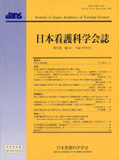Japanese
English
- 販売していません
- Abstract 文献概要
- 参考文献 Reference
- サイト内被引用 Cited by
要旨
目的: 本研究では, DCPプロセスの評価尺度(Discharge Planning-Process Evaluation Measurement: DCP-PEM)を開発するとともに, DCP-PEM の有用性の検証を目的とし, 調査を実施した.
方法: 対象者は病棟看護師で, DCPを導入しているA病院69名, 通常業務を実施しているB病院174名であった. 調査内容は, 基本属性, DCP-PEM, VAS (Visual Analogue Scale), NAS(看護専門職の自律性測定尺度)で, 自記式質問紙を用いた. 項目分析, 同時複数項目削減関連係数法 (CITC), 内的整合性Cronbach's α, G-P分析, DCP-PEMと外的基準のVAS, NAS との相関係数, 既知グループ技法で信頼性・妥当性検証を実施した. DCP-PEM の有用性の検証は質改善のための介入ツール使用の有無により, 介入前後でDCP-PEM の得点変化の比較および感度の検討を実施した.
結果: 1) DCP-PEM の各項目, 領域, 合計の得点の歪度, 尖度が±1.0以内で, CITC はすべて0.471以上と相関が高かった. 各項目, 領域, 合計の得点の Cronbach's α は0.76から0.96と高く, G-P 分析ではすべての項目で有意差がみられた. A病院のDCP-PEM, VAS, NAS の各領域得点, 合計得点は有意に相互の関連がみられ併存妥当性が検証された. 既知グループ技法では DCP-PEM の各領域, 合計の得点で, A病院のほうがB病院に比較し有意に高く, 構成概念妥当性が検証された. 2) 介入ツールを使用した群では, 使用しない群より DCP-PEM の得点は連動して有意に上昇していた項目がみられ, 感度がよく, DCP-PEMの有用性が確認された.
考察: 定量化された DCP-PEM の開発によって, DCPの包括的評価を可能とし, より効果的なDCPの実践に寄与するものと考える.
Abstract
Purpose: The purpose of this study were to develop and validate the Discharge Planning-Process Evaluation Measurement (DCP-PEM).
Methods: The subjects were 69 nurses in “A” hospital wards and 174 nurses in “B” hospital wards. We used a self-report questionnaire including subject characteristics, DCP-PEM, Visual Analogue Scale (VAS) and Nursing Autonomy Scale (NAS). We examined the reliability and validity of the DCP-PEM by item analysis technique, corrected item-total correlation, Cronbach's α coefficient, G-P analysis, Pearson's correlation coefficients in the DCP-PEM with VAS and NAS, and known-groups technique. For validation of the DCP-PEM, we comparatively studied the change in the DCP-PEM score before and after an intervention using a quality improvement tool with a control group, and also examined the sensitivity.
Results: The following results were obtained: 1) Skewness and kurtosis in item, factor and total scores of the DCP-PEM were within ±1.0, and correlation coefficient of CITC in all items was very high over 0.471. Cronbach's α coefficient in item, factor and total scores ranged from 0.76 to 0.96. There were significant differences in all items by G-P analysis. Since factor and total scores of DCP-PEM, VAS and NAS were significantly correlated each other in “A” hospital, the concurrent validity was established. By the known-groups technique, factor and total scores in “A” hospital were significantly higher than those in “B” hospital, suggesting that the construct validity was established. 2) The DCP-PEM scores in some items of the intervention group were higher than those in the control group. The DCP-PEM was validated due to a high sensitivity.
Conclusion: The results suggest that development of the quantified DCP-PEM enables a comprehensive evaluation of the DCP and contributes to greater impacts of the DCP practice.
Copyright © 2005, Japan Academy of Nursing Science. All rights reserved.


